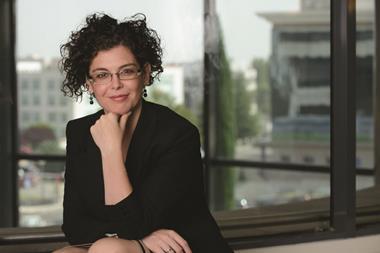Walking around the smart, ultra modern offices of The Crown Estate in New Burlington Place in Regent Street, it's immediately obvious that the staff are comfortable in their new open plan environment. And so they should be; the building has been designed around its occupants, and everything from the video conferencing technology to the rooftop cafeteria complete with outside decking for alfresco dining, has been designed to ensure a productive, comfortable and happy workforce.
They are not far from their previous home, Carlton House Terrace, an opulent but antiquated Georgian building, all grand plasterwork, narrow staircases and small rooms. But even although it is a move of only a few hundred yards, The Crown Estate has come a long way as an organisation. Its portfolio encompasses many of the UK's cityscapes, ancient forests, farms, parkland, coastline and communities, as well as urban, retail, rural and marine properties. It is a portfolio which is valued at more than £5bn, and the management of which demands utmost professionalism and efficiency.
In the last 10 years, the value of the property owned by The Crown Estate has increased by 139%, while annual revenue has risen by 118%. But staying on top of such a vast portfolio requires an astute business sense, and the absolute support of your employees. Chief executive Roger Bright has managed to spearhead organisational change with vision and clarity, and the whole place is energised.
Embracing risk management
Fundamental to this transformation, and a testament to its success, is the way the organisation has embraced the management of risk. John Lelliott, director of finance and information systems explains, "Three years ago our risk management process was too informal. It used to be implicit rather than explicit. Although it was being done, it wasn't to best practice standards or demonstrable to others with whom we share risks."
Lelliott cites the example of employees who would say, 'I've always managed risk, it's a part of everything I do in my job.' "But actively managing risk, and using that knowledge to generate commercial advantage, is an entirely different thing,"
The Crown Estate's history, and that of its forebears, extends over centuries. Its present role was consolidated through an Act of Parliament in 1961. All of the revenue generated by the portfolio (some £180m in 2005) is paid to HM Treasury.
To deliver the business change and achieve better management of risk, the organisation first had to start with understanding where the boundaries lay between itself and its partners and other stakeholders, many of whom also manage other third parties or are the day to day face of The Crown Estate to the tenants of its properties. "When the process started three years ago, these boundaries were not clearly defined," Lelliott says. "We weren't clear where the organisation finished and our partners started. But risk management has helped us define the roles and responsibilities required within the organisation."
Change programme
Finance was the pioneer risk management department, but the embedding of risk management has been a comprehensive change programme which now incorporates:
- finance
- information systems
- procurement
- asset management
- property development
- urban, rural, marine and housing property
- corporate services.
"Our financial managers are the process facilitators and, when necessary, the devil's advocates in the risk debate" comments finance manager Malcolm Poole. "But the board are the ultimate owners, taking a direct role in the ownership of strategic risks and in setting the risk strategy."
"In fact," adds Poole, "everyone in the organisation is involved to some extent. There has been a comprehensive training programme, which includes all personnel, whether they be in the boardroom, the storeroom the countryside."
For example, on the Windsor Estate, managers focus a lot on health and safety by understanding the working practices of estate workers, who could be working at great heights in trees or on buildings. The risk issues are now systematically assessed and logged, with specific actions recommended for every possibility where an objective discussion has concluded that the risk is not low enough to simply accept. Additionally, when new people come into the organisation their input is actively encouraged and welcomed, so that the organisation can take a fresh view of where risks sit. "As an employer, we seek out talented and experienced individuals. The management of risk process gives them a very direct means to bring that to bear for the management of the Estate" says Lelliott.
Achieving buy-in
"The major achievement of the organisation has, without a doubt, been the buy-in of all departments," Poole says. "We consciously chose not to adopt a heavy handed or detailed approach at the start and so there is no antagonism. Everyone is shown why risk management is relevant to their specific role, and this helps with getting proper engagement because people can see the advantages to themselves and to the organisation."
The approach has engendered both a feeling of collective responsibility and a transparent culture. "Decisions are increasingly based on the perceived facts, good reasoning and consensus, often made in group situations," comments Steve Daniels from Siemens Insight Consulting, who has helped The Crown Estate adopt the best practice approach to risk management.
Lelliott says, "It's impossible to demonstrate fiscally just how much benefit risk management has realised for the organisation, but there is a mood of certainty and optimism here which is a direct result of being able to make more informed decisions".
"Often the answer to just how good you are at managing risk is answered by how innovative you've been," comments Daniels. "The Crown Estate is now mature enough to stop analysing bread and butter risks in detail and is increasingly focusing on the strategic risks to its plans and indeed on the implicit opportunities that these can represent."
Poole agrees. "When risk management principles are fully embedded in the organisation, there are times when, by your own rules, you can stop analysing risk and just go and get the job done, confident that there is every likelihood of success. We've done enough of the basics now to be confident that some things just don't need to be analysed - it's already been done and the necessary controls are built into the way we work."
This confidence in knowing that the foundations are there has resulted in much better decision making. The organisation is able to understand why things go wrong, and even more importantly why they go right.
In May 2006, The Crown Estate exchanged contracts to sell the freehold of 40-53 Bedford Square, London WC1. These £54.5m properties have been sold because the Estate identified that it needed to reduce the level of risk and volatility to its long term performance and to rebalance key parts of the overall portfolio. The income generated from this risk management decision will be used to invest in property which passes the organisation's stringent risk evaluation criteria. It is this approach which has strengthened the overall performance of the organisation.
Poole says: "The M_o_R (Management of Risk) framework has had a positive impact on the processes operated by The Crown Estate. The visibility of our internal control has been enhanced and we now publish internal control statements and make regular risk dashboard reports to the management board. These allow us to monitor the effectiveness of the controls applied."
There is one thing to which Lelliott and Poole repeatedly refer, and which, they say, is fundamental to The Crown Estate's ongoing success. "Our biggest strength is the support and ownership of risk management as an enabling tool by our chief executive, Roger Bright," Poole comments. "We would not be as successful in embedding risk management if we did not have his support and, through him, the active and enthusiastic commitment of senior management".
Daniels adds: "The Crown Estate has very much taken risk management to its heart and its everyday language is now very much risk based, with results to prove it."
- Kate Winter, journalist, talked to members of The Crown Estate's risk team.
COVERAGE OF M_O_R
The key areas that are addressed in M_o_R are:
- the requirements of corporate governance - including more focused and open ways of managing risk
- the need for a 'risk owner' at senior level, for an activity (for example strategy, programme or project). He or she is supported by risk owners at everyday working levels as appropriate for the activity and risk exposure
- the need for improved reporting and upward referral of major problems and opportunities and the potential resolution approaches
- the need for shared understanding of risk management at all levels and with partners, combined with consistent treatment of risk
- managing project risk in the wider context of programmes of change and the business.



















